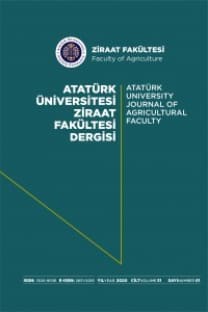MEYAN OTUNUN (Glycyrrhiza Sp.) KABAYEM OLARAK KULLANILMA OLANAKLARI II
Araştırmanın kesim dönemine kadar işlenen I. Kısım, Ziraat Dergisinin Mart 1975 Cilt 6, Sayı I. de yayınlanmıştır.POSSIBILITIES TO USE THE LIQUORICE HAY(Glycyrrhiza Sp.) AS A ROUGHAGE IN CATTLE RATIONSLiquorice plant covers morethan one millions of acres of usableland in the south and south easternpart of 'Imkey. Altoughı it İsconsidered as a weed by the farmersbut it wastıhought woıi1hwihilefor ııS to lI1ves'tiıgate tıhe poSisiib'İHtiesrto use this plant as a roughagein cattle rations.The experiment was carrledout in tıhe Alparslan Sıtaie Farm .inMuş province. Fi!f.ty hea:d of eatde(30 Alberdeen Anıguses, 20 Herefords)we!'e diSltrilbuted 'İnto firvegroups of ten each (4 Herefords6 Anguses).Coneentrates fed to eadh groupwere compuselcI of barley, wheatbran, sunflower oil meal and containcd[2 % digestihle protein.Eadh ıgroup received the same amountof concentr:ates.Tihe roughage paNiün of tıheratian'S in the treatıınents were asfallow:s :Group 1 1.0 Kg. Liquorice hay + 3.0 Kg. pTairie hay» 2 2.0 ı> » » 2.0 » » »» 3 0.0 ı> » » + 4.0 ') ı> »» 4 4.0 » » » + 0.0 » » »» 5 3.0 » » » + 1.0 » » »After 100 daıys of feeıding tıheeXlperiment ternıinated. The statisticalanalysis showed no significantdififerences 'between the groups.This resuLt indicated t!hat ·tihe Li.quoııİcehıay had no signıificanrt effecton the Hveweight gain.s. As II matterof .tact ,the daiıly g.ains in tftıegr;oups were close to eadh other.The da'İly ıga~ns in ;the first and secondgroups were .8000 and .0795Kg. respectively.Since no significant differenceswere obıserved between the rationsit is then be possiibIe to caneIudeI<The Liquorice hay can besuhsıtitute for prairie hay in cattlera tionsı>. The same result will alsoemilile US to say «The Liquorkehay can be substitute for straw incattIe rations».At the end of the experimentthe cattle were transportea toMeat Packing Plant in Erzurumprovince by lomes for slaughter.,During tıhe process of slauıgihter,skinJ feet and Iirver weights we·re taken. The conclutions arri'Vedafter applying sta:tİosticaI analys;iswere giJven below.Skin weİghts. 11he d'ifferencesin S'kin weights between· gnmpswere found not S İgnificant, but'1!he dififerences betweenthe Ibreedıs55were significant (P < .05). Theskin weights in all the groups werein favaur oc Herefurds.Head welghts. The calculatalditferences between gııaups werertot signi:ficant, 'but the differences, in head weights between thebreeds were significant (P<.05) ,and the weight' differences werein favour of Herefords.Feet welghts. Hereford feetweights were higher than Angu.sfeet weights, and the differenceswere significant (P< .05). Furthermorethe feed X breed interaetionswere also significant.Liver weights. The differencesbetween gtorups in liver weights we·re not sigrnficant Ibut betweenbıeeds 'were significant. In somegroups Herm-<ırd liveJ1s were hea'Vıi·er filan Angu.'S TivellS and in· someonhers 'Vice· versa. Slnce Herefordswe e hea'V.ier than Anguses funıdamentallytheir livers should alsobe heavier than Angus livers, butthis trend were not observed.Fat thickness. In none of thegroups fal tibkkness were O;Ter4 mm. The hiıghest value cakulatalfor the Berefords wa:s in the firstand fifth groups aıs 3.6 mm. whilefor Angııses İn the .first .group alS3.16 mm. ActualIy these figuresare VeJ'Y 1O'W for 11ıe Mıgus and.Herefoııds, since dur natİve 'breedsyrields more faıt than tlhe bree.dsmen'tioned above.Eye muscle atea. Eye mUS()learea for Herefordis weı::e 'm~erthan Anguses İn 2 and 3 groupsBut the situadon was different56in ıst 3rd and 4th groups. Eyeı:rruscle area in ,rhese groups wer~in favout of .Angus 'breed. Alclıough .the average figu.re for Herefor.dsWa's very high 'in group :5 because,of one animal lıav.ing very lal1ge eyemuscle area.Kldney fat. No- biıg di.fifereneeswere ohserved between gmups and. breeds for tlhi'S aharacter. Aotuallyit waS not possible to decide whetherthe differences were signifi~cant, because no 'statisticalanalysis was applied.Confonnatlon. No confonnationdifferences between groupsand between breeds were ohservedHomegenity in confoqnation wasalso noticed in both breeds.Fleshing. All the gmups and. the brl",ecis had almosıt saırne gradesfor Eleshing. A1thou.gh smaIl dilfereneesihaıd occuıred in some groupsfor both breeds, but Rerefordss.höwed more homogenlty.Cooler shrinkages. The d1fferencesin codler shrinkage valuesbetween groups and betweenbreeds were not signifıcant. Thefigures calculated for coolershrinkages for the breeds vverealmost the same as in nativebree'cJs.Boneless 'luts. Using the .dataobta'ine:d from the carcass weight,r,~b eye area, internal faıt and fatt'hickneslS, the honeleıss cuts indI1uck, rib, loin and rump were cal·cclated. S~nce the va'lues were notsubjected to statistical arialysrrs, thecalculated differences betweengroups and ·between breeds wereused as descriptive data.
